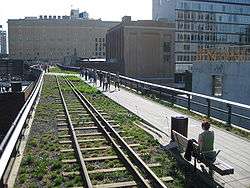Walkway over the Hudson
| Walkway over the Hudson | |
|---|---|
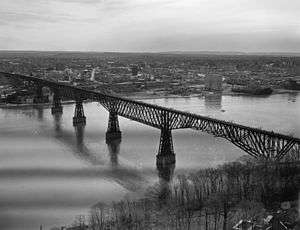 Poughkeepsie-Highland Railroad Bridge in 1978, viewed from the northwest, in Highland | |
| Carries |
railroad (1889–1974) walkway (2009–present) |
| Crosses | Hudson River |
| Locale | Poughkeepsie, New York to Highland, New York |
| Characteristics | |
| Design |
Cantilever deck truss bridge |
| Total length | 6,768 feet (2,063 m) |
| Width | 35 feet (11 m)[1] |
| Height | 212 feet (65 m) |
| Longest span | 2 × 548 feet (167 m) |
| Number of spans | 7 |
| Clearance above | unlimited |
| Clearance below | 160 feet (49 m) |
| History | |
| Constructed by | Manhattan Bridge Building Company |
| Construction begin | 1886 |
| Construction end | 1889 |
| Opened |
January 1, 1889 (railroad) October 3, 2009 (walkway) |
|
Poughkeepsie-Highland Railroad Bridge | |
  | |
| Location | Poughkeepsie, New York |
| Coordinates | 41°42′38″N 73°56′40″W / 41.71056°N 73.94444°WCoordinates: 41°42′38″N 73°56′40″W / 41.71056°N 73.94444°W |
| Built | 1886–1888 |
| Architect | O'Rourke,John F.; Union Bridge Co. |
| NRHP Reference # | 79001577 |
| Added to NRHP |
February 23, 1979 (original) May 20, 2008 (additional documentation)[2][3] |

The Walkway over the Hudson (a.k.a. Poughkeepsie Bridge, Poughkeepsie Railroad Bridge, Poughkeepsie-Highland Railroad Bridge, High Bridge) is a steel cantilever bridge spanning the Hudson River between Poughkeepsie, New York, on the east bank and Highland, New York, on the west bank. Built as a double track railroad bridge, it was completed on January 1, 1889, and formed part of the Maybrook Railroad Line. It was taken out of service on May 8, 1974, after it was damaged by fire. It was listed on the National Register of Historic Places in 1979, and its entry updated in 2008.[2][3] It was reopened on October 3, 2009, as a pedestrian walkway and the longest footbridge in the world as part of the new Walkway Over the Hudson State Historic Park.[4]
History
Construction
In 1868, an engineer proposed a railroad bridge across the Hudson River at Poughkeepsie, in a letter published in the Poughkeepsie Eagle newspaper. The proposal seemed so absurd that the Eagle ridiculed it, and it was effectively forgotten until 1868.[5]
Over the years, many plans had been made for a fixed span across the Hudson River south of Albany to replace numerous car float and ferry operations. One of the most persistent was originally chartered in 1868 as the Hudson Highland Suspension Bridge Company, whose proposed bridge would have crossed from Anthony's Nose to Fort Clinton, now roughly the site of the Bear Mountain Bridge. It was never built.
The Poughkeepsie Bridge Company was chartered in June 1871 to build the bridge, and J. Edgar Thomson of the Pennsylvania Railroad was persuaded to support the effort. Contracts were let to a firm called the American Bridge Company (not the company of the same name founded later), but the Panic of 1873 intervened and the scheme collapsed.
In 1886, the Manhattan Bridge Building Company was organized to finance the construction. Among the prominent backers was Henry Clay Frick, the coal tycoon and associate of Andrew Carnegie. The Union Bridge Company of Athens, Pennsylvania, which had completed the Michigan Central cantilever bridge at Niagara (see Niagara Cantilever Bridge), was subcontracted to build the Poughkeepsie Bridge. Dawson, Symmes and Usher were the foundation engineers, while John F. O'Rourke, P. P. Dickinson and Arthur B. Paine were the structural engineers. The bridge was designed by Charles Macdonald and Arthur B. Paine. As is typical for cantilever bridges, construction was carried out by constructing cribwork, masonry piers, towers, fixed truss sections on falsework, and finally cantilever sections, with the final cantilever interconnection (suspended) spans floated out or raised with falsework. The first train crossed the bridge on December 29, 1888, and it was formally opened for scheduled passenger service on January 1, 1889.
Considered an engineering marvel of the day, the bridge has seven main spans. The total length is 6,768 feet (2,063 m), including approaches, and the top of the deck is 212 feet (65 m) above water. It is a multispan cantilever truss bridge, having two river-crossing cantilever spans of 548 feet (167 m) each, one center span of 546 feet (166 m), two anchor (connecting) spans of 525 feet (160 m), two shore spans of 201 feet (61 m)each, a 2,641 feet (805 m) approach viaduct on the eastern bank and a 1,033 feet (315 m) approach viaduct on the western bank. All seven spans were built of newly available Bessemer Process "mild" (between 0.16% and 0.29% carbon) steel, while the two approach viaducts were built of iron. It formed part of the most direct rail route between the industrial northeastern states and the midwestern and western states.[6]
Operation
.jpg)
The bridge was the only fixed Hudson River crossing between Albany and New York City until the construction of the Bear Mountain (road) Bridge in 1924, and was advertised as a way to avoid New York City car floats and railroad passenger ferries. Ownership of the bridge passed through several railroads including the Central New England Railway (CNE), New York, New Haven & Hartford Railroad (NH), Penn Central (PC) and Conrail.[7]
In 1912, the bridge was strengthened to handle heavier freight trains by engineer Ralph Modjeski, of the famed bridge civil engineering firm Modjeski and Masters, who added a third line of trusses down the middle, a central girder, and interleaved columns.[8][9] In 1917–18, the double tracks on the bridge were converted to gantlet track operation to center the weight of heavier NH 2-10-2 steam locomotives. Even so, trains were restricted to 12 miles per hour.[10] In 1959, the gantlet tracks were replaced by a centered single track.[7]
During World War II, the bridge was a vital link for war freight traffic, guarded around the clock by United States Army soldiers. At its peak, nearly 3,500 train cars crossed over the Hudson on a daily basis.[7]
Decline
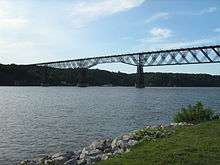
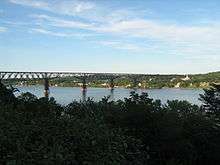
Traffic across the bridge began a slow decline in the 1950s as industry shrank in New England and with it the need for the raw materials railroads excelled at transporting. Traffic from the connecting New York, Ontario & Western ceased when that railroad shut down in 1957. Another connection, the coal-, slate-, and cement-hauling Lehigh & New England shut down in 1961. At the same time, some new traffic began crossing the bridge, such as the New Haven's "Super Jet", one of the first trains to carry truck trailers. The Penn Central's acquisition of the New Haven in 1969 discouraged connecting traffic with the Erie Lackawanna, which competed with other Penn Central routes. After 1971, only one through train in each direction, for Erie Lackawanna, crossed the bridge.[11]
While the Penn Central did not connect with the old New Haven on the west side of the bridge, it came close. For a short time in 1969 and 1970, Penn Central ran a daily train between Cedar Hill Yard in New Haven, Connecticut and Potomac Yard in Alexandria, Virginia, by way of the Lehigh and Hudson River Railway, which connected with the Penn Central Belvidere Division in Belvidere, New Jersey, 72 miles south of the old interchange with the New Haven at Maybrook Yard in Maybrook, New York. The service ended in a dispute over haulage charges and the traffic was diverted to the longer all-Penn Central route through Selkirk, New York. Ironically, the only reason the Lehigh and Hudson River was not part of the Penn Central was because a Penn Central predecessor, the Pennsylvania Railroad, had prevented the New Haven from acquiring it in 1905.[11] The Lehigh and Hudson River and Erie Lackawanna were finally joined with the Penn Central when all were taken over by Conrail in 1976.
On May 8, 1974 a tie fire damaged about 700 feet (210 m) of decking and underlying girders on the bridge's eastern section.[12] It was likely started by a spark from an eastbound freight train that had just crossed the span.[13] The Penn Central had neglected the bridge's fire-protection system, which had no water on the day of the fire, and had laid off employees who kept watch for such fires.[5] A photograph of the last train, a run-through from the Erie Lackawanna, was included in a 40th anniversary web feature by the Poughkeepsie Journal.[14]
In August 1974, the Penn Central applied for $1.75 million to repair and improve the bridge from the federal government through the Regional Rail Reorganization Act of 1973.[15] By 1975, efforts had shifted to acquiring a combination of state and railroad funding. In November 1975, a formal agreement between the New York State Department of Transportation and the trustees of the Penn Central was approved, allowing the $359,000 insurance payout for the bridge to be spent on repairs, with the state paying the rest. In December, U.S. Representative Benjamin A. Gilman announced that $486,000 appropriated by the state legislature for repairs was undergoing final review by the state.[16] Authorization for the state to spend its share on bridge repairs had still not been given when, on April 1, 1976, ownership of the bridge changed with the inception of Conrail.[17] Having been forced to include the route over the bridge (the Maybrook Line) in its new system at the behest of Connecticut Senator Abraham Ribicoff, Conrail announced that it would not promise to repair and use the bridge despite a Connecticut foundation's offer to pay half the repair cost if the bridge were used again. The railroad further said that other work required to make the route usable would raise the reactivation cost to $45.8 million.[18][19]
Seven years passed; pieces of the bridge's eastern approach viaduct over Poughkeepsie began falling onto U.S. Route 9 below, damaging passing vehicles. In response, the city sued Conrail and forced it to spend $300,000 in 1983 to remove the decking over the superstructure. Conrail then sought to dispose of the unused bridge and eventually abandoned and tore up its Maybrook Line between Hopewell Junction and Maybrook, New York in 1983–1984.[19]
Conrail made initial plans to sell the bridge to bridge enthusiast and lawyer Donald L. Pevsner, by an option granted to him on February 1, 1984.[20][20][21] Later in 1984, Conrail advised Pevsner to take title of the bridge in a shell corporation, with no assets but the bridge and no funds to pay for necessary insurance and maintenance; the railroad just wanted to be rid of the bridge, whatever the dubious ethics of such disposal. This decision was made personally by then-Conrail Chairman L. Stanley Crane, at a time when Conrail was owned by the U.S. Government. Pevsner refused, and let his option expire on November 1, 1984.[5] One day later, on November 2, 1984, Conrail sold the bridge for $1 to a convicted bank swindler (SEE Poughkeepsie JOURNAL: various issues) and ex-felon named Gordon Schreiber Miller, of St. Davids, Pennsylvania, to "get it off the books.".[22] For the next fourteen years, Miller and his successor, Vito Moreno, spent little or nothing on maintenance or insurance, while attempting to drastically increase the $25,000 annual rent paid by Central Hudson Gas & Electric Corporation for its three 115,000-volt and three 69,000-volt power lines across the Hudson, attached to the south side of the bridge since 1949.[23] In response, Central Hudson de-energized those power lines and relocated them under the river in 1985, thereby ending Miller's only source of bridge income.[19] During this long period, critical bridge navigation lights were mostly inoperative, resulting in large U.S. Coast Guard fines against the Miller corporation that all went unpaid. Further, all of the 2,200-pound brackets that connected Central Hudson's de-energized high-tension power lines to the south side of the bridge continued to deteriorate by rusting. Though Central Hudson admitted that it normally had a legal duty to remove its abandoned power lines, it refused to remove its abandoned bridge-affixed lines, instead relying on a claim that it no longer owned the lines at issue pursuant to prior litigation with Conrail that was decided on September 26, 1984,[24] and won a similar legal opinion before the New York State Public Service Commission in 1995, which was left to stand on April 1, 1999 when The Poughkeepsie-Highland Railroad Bridge Company, Inc., as the successor owner to Gordon Schreiber Miller and Vito Moreno, withdrew its 1998 complaint against Central Hudson on January 27, 1999.[25]
Restoration
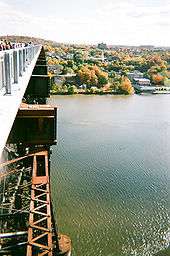
On June 4, 1998, following the long nonpayment of Dutchess and Ulster County taxes on the bridge by prior owners Gordon Schreiber Miller and his successor, Vito Moreno, Moreno deeded the bridge to a nonprofit volunteer organization called Walkway Over the Hudson, which took title through its nonprofit New York corporation, The Poughkeepsie-Highland Railroad Bridge Company, Inc., hoping to turn it into a pedestrian and cyclist walkway. The deed was recorded in both Counties on June 5, 1998. The former Central Hudson power lines were finally removed in 2009, as part of Walkway construction. On December 21, 2010, the Walkway corporation conveyed the entire structure to the New York State Bridge Authority, which restored high-limit liability insurance and "deep-pocket" maintenance assurance for the first time since November 2, 1984.[26] On September 5, 2009, conversion work and repairs to the structural steel and the laying of concrete slabs for the walkway were completed. The volunteer head of "Walkway", as it is known locally, said in 2008, "We think people will come from all over. It's the equivalent of the Eiffel Tower, or the Golden Gate Bridge."[27] The project initially received support from local residents, city and state officials totaling about $1,000,000, plus forgiveness of $550,000 in taxes inherited from the previous owners.[28][29] Then, Walkway solicited funding from both the State and Federal governments, for historic preservation, and from private philanthropic organizations.[30] Funding sources as of January 13, 2016 include:[31]
- The Dyson Foundation, which has donated almost $20 million, including guaranteeing $8.1 million in loans that were made by Ulster Savings Bank and M&T Bank to complete the project in 2009, plus $2.3 million to build the elevator that was completed in 2014. The original $10 million in loans has been paid-off, and the remaining $1.6 million, owed to M&T Bank alone, is scheduled to be paid-off in 2019.
- New York State funding, from various entities, totals about $22.5 million.
- Federal government funding, from various entities, totals about $3.5 million.
- Scenic Hudson, Inc., which has donated $1 million.
- The Jane W. Nuhn Charitable Trust has donated $500,000.
- The M&T Charitable Foundation has donated between $50,000 and $100,000.
- Amy P. Goldman and Sarah Arno have donated between $100,000 and $250,000.
The total budget as of October, 2009 totaled about $38.8 million. The Walkway Group raised a total of $30.7 million as of October 23, 2009. The $8.1 million deficit was financed by lines of credit from Ulster Savings Bank ($4 million) and M&T Bank ($4.1 million) that were drawn-upon to complete the project in 2009.[32] These lines of credit were converted to loans, with an additional $2.3 million allocated to 2014 elevator construction, and were guaranteed by The Dyson Foundation (see above).[33]
The project was separated into four phases, with the first two completed as of October, 2009:[34]
- Phase 1 – attain ownership of the bridge.
- Phase 2 – structural analysis of the bridge and creation of a comprehensive plan, including budget and timeline for completion. The group also had to find funding for the project and secure funding for the start of construction.
- Phase 3 – construct and open the first 1,800 feet (550 m) of the walkway on the Ulster side. The Dutchess side will get an elevator and 900 feet (270 m) of walkway. This phase was complete on October 3, 2009 (the grand-opening date), excepting a $2.3 million elevator installation in Poughkeepsie that was completed during the summer of 2014.
- Phase 4 – construct and open the remaining 4,068 feet (1,240 m) of the walkway and its resultant connections to the Hudson Valley Rail Trail in Highland and the Dutchess Rail Trail in Poughkeepsie. The walkway was completed on September 5, 2009, and opened to the public on October 3, 2009. The Hudson Valley Rail Trail connection was finished in the autumn of 2010. The Dutchess Rail Trail connection has also been completed.
The piers were inspected in 2008 and given a clean bill of health. Similarly, Bergmann Associates, P.C. (of Rochester and Albany, New York), project engineers and managers, has stated in writing that the wind loads were carefully examined for the replacement, solid-concrete Walkway decking, and that this item is not a safety problem.[35] The decking work was completed on September 5, 2009. Walkway opened the bridge to the public on October 3, 2009, in time for the quadricentennial celebration of Henry Hudson sailing up the Hudson River, and that day handed it over to the New York State Office of Parks, Recreation and Historic Preservation for management. Despite this, inevitable comparisons have been drawn to the similar Kinzua Bridge, in northwestern Pennsylvania, which blew over in a microburst tornado when the bolts connecting the steel framework to the piers failed. Ironically, renovation work was going on to strengthen the corroded areas when the tornado destroyed most of this former Erie Railroad viaduct. During Hurricane Irene, residents living within 500 feet of the Poughkeepsie Bridge were evacuated as a precaution, and emergency repairs to reduce bridge sway (by the addition of new steel X-braces, supplanting the original turnbuckle-adjusted tension rods) were hurriedly installed.
The bridge became a National Recreation Trail in 2009.[36]
Walkway over the Hudson State Historic Park
The opening ceremony of the Walkway Over the Hudson State Historic Park, on October 3, 2009, featured music by Pete Seeger, and was attended by Governor David Paterson, Senator Chuck Schumer, Congressman Maurice Hinchey, President of nearby Vassar College Catharine Bond Hill,[37] John May, engineer of the last train across the bridge, and other officials. Paterson said, "This bridge is now the longest footbridge in the world."[38]
The walkway immediately saw many more visitors than the expected 267,000 per year. In its first three months, it saw about 415,000 people.[39]
The Bridge Walkway is operated as part of the New York State Historic Park System, open from 7:00 a.m. to dusk. Limited, wheelchair-friendly parking is available on either end of the bridge:
- East End: 61 Parker Avenue, City of Poughkeepsie; charges $5 fee[40]
- West End: 87 Haviland Road, Highland[40]
Restrooms are at the ends of the Walkway, although at the time of a 2008 engineering survey of the bridge, there was "not a johnny on the spot".[41] Pets are permitted, but owners should bring equipment to clean up. Bicycles and roller blades (but not skateboards) are permitted, and the Walkway is flat and relatively wheelchair-friendly.[40]
New additions
On May 22, 2013, the Walkway Over the Hudson organization opened a new East Pavilion, built entirely through donations of money and services. The pavilion will be occupied by the volunteers who serve as Walkway Ambassadors who greet and offer assistance to visitors.[42]
In October 2013, a "mobile Web tour" was introduced, consisting of QR codes at locations throughout the Walkway which link to Web content related to the spot.[43]
In summer 2014, an elevator connecting Upper Landing Park to the Walkway was opened. This allows visitors to reach the center of the span via a more direct route. It also connects the Walkway to the Poughkeepsie waterfront area, which is near the railroad station, Mid-Hudson Children's Museum, and Waryas Park.
Events and incidents
The first footrace on the walkway occurred the day after the official opening on October 4, 2009. The 5k race started on the Highland side, crossed to the Poughkeepsie side and turned around at the parking lot and finished back in Highland. The race was won by James Boeding in a time of 16:26. The female winner was Kira DeCaprio in 20:12. There were 660 recorded finishers of the race.[44] The 5K race, called "Treetops to Rooftops", has become an annual event, organized by the Mid-Hudson Road Runners Club.[45]
On May 15, 2010, LED-based lights were turned on for the first time, designed to allow nighttime use of the bridge, though due to funding limitations this is expected to only be used on special occasions. Some 3,000 people paid $5 apiece to attend the sold-out ceremony.[46] Crowd management presented a problem, prompting criticism and an apology from the Walkway organization, but ultimately no incident or injury.[47]
On February 20, 2011, Don Kampfer, a Korean War veteran, died of a heart attack he suffered while participating in a monthly ceremony to retire and replace the American flag on the Walkway. Kampfer is the second person to die on the Walkway, the other also being from a heart attack while walking over the bridge.[48]
On July 27, 2011, an Ulster County man in his late 20s jumped off the bridge after it closed in the evening. His entry to the bridge set off an alarm, bringing the police, who found only his belongings; a suicide note was found later at his home. The man's body was recovered two days later.[49][50]
Though typically closed at sunset each day, the Walkway often has events after sundown. Some of these openings (such as for Independence Day and in December) include fireworks displays.[51] In July 2012, in a photograph taken from the Walkway, an amateur photographer captured what the New York Daily News described as a "breathtaking juxtaposition", capturing fireworks and a bolt of lightning in the same image.[52] Some of the night time events have featured members of the Mid Hudson Astronomical Association, who have provided telescopes for public viewing of the moon, stars, and planets from the Walkway,[53] along with lectures by local astronomer Bob Berman.[54]
The inaugural Walkway Marathon was held on June 13, 2015, with full and half marathons and a 5K run. The races sold out at 2500 athlete registrations and became verified as the first "Green" race in NY State by Athletes for a Fit Planet. The Walkway Marathon has become an annual event with the 2016 races held on June 12, 2016. The event's Health and Wellness Expo and Race Packet Pickup were held on Saturday, June 11. A new addition to the 2016 event was the Think Differently Dash, a one-mile race for people with physical and developmental disabilities.
See also
- Poughkeepsie Bridge Route
- Mount Carmel District
- List of bridges documented by the Historic American Engineering Record in New York
- List of fixed crossings of the Hudson River
References
- ↑ http://atfiles.org/files/pdf/WalkwayOverHudson.pdf
- 1 2 National Park Service (2008-04-15). "National Register Information System". National Register of Historic Places. National Park Service.
- 1 2 "New listings". National Park Service. May 30, 2008.
- ↑ Longest Footbridge"
- 1 2 3 Mabee, Carleton (2001). Bridging The Hudson: The Poughkeepsie-Highland Railroad Bridge and Its Connecting Railroad Lines. Purple Mountain Press. ISBN 1-930098-24-3.
- ↑ POUGHKEEPSIE EAGLE Souvenir Edition dated January 1, 1889; plus independent engineering articles from the period.
- 1 2 3 Drury, George H. (1994). The Historical Guide to North American Railroads: Histories, Figures, and Features of more than 160 Railroads Abandoned or Merged since 1930. Waukesha, Wisconsin: Kalmbach Publishing. pp. 222–229, 248. ISBN 0-89024-072-8.
- ↑ catskillarchive.com
- ↑
- ↑ Hartley, Scott (1992). New Haven Railroad: The Final Decades. Piscataway, NJ: Railpace. p. 96. ISBN 0-9621541-5-6.
- 1 2 Swanberg, J.W. (January 2005), "Railroad Blueprint: Maybrook, New York", Trains Magazine: 50–59
- ↑ Cruz, Roberto (May 7, 2014). "Railroad bridge fire 40th anniversary: Fire in the sky". The Poughkeepsie Journal. Retrieved January 2, 2015.
- ↑ Sutherland, Joseph (May 9, 1974), "Fire Closes Rail Bridge 3 Months", The Evening News, Newburgh, NY, p. 1
- ↑ Cusumano,, Chris (May 7, 2014). "INTERACTIVE: How the Poughkeepsie Railroad Bridge fire changed history". The Poughkeepsie Journal. Retrieved January 2, 2015.
- ↑ "Fate of Poughkeepsie Rail Bridge Up to Court", The Evening News, Newburgh, NY, p. 4A, August 30, 1974
- ↑ "Poughkeepsie Railroad Bridge Funds Reviewed", The Evening News, Newburgh, NY, p. 4A, December 16, 1975
- ↑ "Carey Asked to Fix Bridge", The Evening News, Newburgh, NY, p. 4A, April 9, 1976
- ↑ "Bridge Help Refused", The Evening News, Newburgh, NY, p. 3A, May 22, 1976
- 1 2 3 Poughkeepsie Journal news stories.
- 1 2 Poughkeepsie Journal news stories (1984).
- ↑ Earlier demolition bids received by Conrail in 1983 were reported in Carleton Mabee's book, "Bridging The Hudson: The Poughkeepsie Railroad Bridge and Its Connecting Rail Lines", also cited in Footnote 3.
- ↑ For the entire saga of Donald Pevsner's involvement with Conrail, which saved the bridge from Conrail demolition in 1984, see his Oral History Project interview by the Hudson Valley Institute at Marist College, updated to March 17, 2004, at: www.hudsonrivervalley.org/themes/pdfs/pevsnerdonald
- ↑ Documentation of the annual rent amount paid by Central Hudson to Conrail prior to the Miller bridge purchase is located in New York State Public Service Commission records; in Court documents for the case of Consolidated Rail Corporation v. Central Hudson Gas & Electric Corporation (cited in Footnote 9); and in Poughkeepsie Journal news stories in 1984-5.
- ↑ Consolidated Rail Corporation v. Central Hudson Gas & Electric Corporation, Supreme Court, County of Westchester, State of New York.
- ↑ Dispute between Central Hudson Gas & Electric Corporation and The Poughkeepsie-Highland Railroad Bridge Company, Inc., New York State Public Service Commission CASE 98-E-0439.
- ↑ Walkway organization press release, December 22, 2010.
- ↑ "Hudson rail bridge to be high-altitude walkway". Associated Press. October 26, 2008.
- ↑ Malone, Michael (2007-01-21). "Rusty Bridge, Great Views and Soon, a Walkway?". The New York Times.
- ↑ Merchant, Robert (2006-11-27). "History buff plugs for bridge: Yorktown man joins fight for railroad span". The Journal News.
- ↑ "Walkway group takes wraps off Poughkeepsie Railroad Bridge plans". Mid-Hudson News. 2007-06-05.
- ↑ Walkway Over The Hudson October, 2009 online newsletter.
- ↑ Walkway Over The Hudson online newsletter, Fall, 2009.
- ↑ Email from Andrea Reynolds, The Dyson Foundation, to Donald L. Pevsner, dated January 13, 2016.
- ↑ "Phases". Archived from the original on 2007-01-05. Retrieved 2007-06-06.
- ↑ Email from Peter Melewski, Bergmann Associates, P.C. Project Manager (Albany, New York office), to Donald L. Pevsner, dated December 4, 2009: in possession of the Walkway Group.
- ↑ "2009 National Recreation Trail designations". National Trails System. Retrieved 2011-01-01.
- ↑ "Poughkeepsie unveils historic Walkway Over Hudson". Miscellany News. Poughkeepsie, New York. October 7, 2009. Retrieved 2009-12-22.
- ↑ "Walkway Opens, Thousands Explore Unique State Park". Poughkeepsie Journal. Poughkeepsie, New York. October 3, 2009. Archived from the original on April 2, 2015. Retrieved 2009-10-06.
- ↑ "New walkway exceeds expectations, as folks flock to bridge". Poughkeepsie Journal. Poughkeepsie, New York. December 29, 2009. Archived from the original on January 2, 2010. Retrieved 2009-12-30.
- 1 2 3 http://www.walkway.org/directions
- ↑ Walkway Over the Hudson: Final Design Report and Environmental Assessment, Bergmann Associates, 2008-02-22, p. V-3
- ↑ ‘Walkway East Pavilion' Opens, Donors Thanked at Ceremony, Walkway News, Press Releases, 2013-05-22
- ↑ Walkway app a high-tech trek, Poughkeepsie Journal, 2013-10-22
- ↑ "Race results" (PDF). Retrieved 2009-11-11.
- ↑ "Mid-Hudson Road Runners Club".
- ↑ "Walkway lights come on, to delight of thousands". Poughkeepsie Journal. Poughkeepsie, New York. May 16, 2010. Archived from the original on May 18, 2010. Retrieved 2010-05-16.
- ↑ "Official Facebook update by Walkway organization". Retrieved 2010-05-16.
- ↑ "While honoring flag, veteran suffers fatal heart attack on Walkway". Poughkeepsie Journal. Poughkeepsie, New York. February 24, 2011. Retrieved 2011-02-25.
- ↑ "Police ID Walkway jumper as New Paltz man". Daily Freeman. Kingston, New York. August 3, 2011. Retrieved 2012-05-22.
- ↑ "Body of man who jumped from Hudson Walkway found". Seattle PI (from Associated Press). Seattle, Washington. July 29, 2011. Retrieved 2011-07-30.
- ↑ "Fireworks spectacular raised money for Walkway Over the Hudson". Mid Hudson News. Retrieved 4 December 2013.
- ↑ Browdie, Brian. "Amateur photographer captures lightning bolt during Independence Day fireworks display". NY Daily News. Retrieved 4 December 2013.
- ↑ "Member Moonwalk & Skyfest". Walkway over the Hudson. Retrieved 4 December 2013.
- ↑ "BARDAVON & WALKWAY OVER THE HUDSON PRESENT ASTRONOMER BOB BERMAN". Bardavon Theatre. Retrieved 1 June 2014.
External links
| Wikimedia Commons has media related to Walkway Over the Hudson. |
- Walkway organization
- Walkway Over the Hudson State Historic Park
- Background information
- Poughkeepsie Bridge at Structurae
- Bridging the Hudson at Poughkeepsie 1871 Bridge Prospectus
- CatskillArchive.com copy of Scientific American article of February 5, 1887 (written during construction) has data on steel strength and testing
- Project Write: Documenting the Walkway (documentary video)
- Poughkeepsie Journal interactive feature on history of railroad bridge and its 1974 fire
- Illustrations and images
- Historic American Engineering Record (HAER) No. NY-131, "Poughkeepsie Bridge"
- CatskillArchive.com Construction etchings and description includes etching of cantilever cranes (steam donkey powered) constructing cantilevers
- Walkway.org History section, has pictures of falsework and cantilever cranes.
- CatskillArchive.com illustration of bridge (side view) with bent, floor, viaduct details
- Preservation efforts and historic register information
- Bridgeweb.com article on historic cantilevers and preservation efforts
- CatskillArchive.com Poughkeepsie Journal 1974 fire article
- CatskillArchive.com POK Journal other articles of interest
- National Register of Historic Places nomination 1978 Announcement
